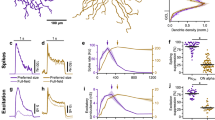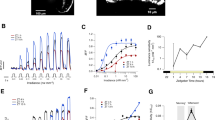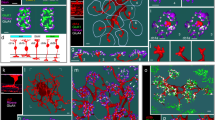Abstract
The first synapse in the vertebrate visual system is made between the photoreceptors and the bipolar cells. Bipolar cells fall into two distinct classes according to whether the cell hyperpolarizes or depolarizes to small centred spots of light. Most evidence indicates that the light-induced hyperpolarization of the photoreceptors suppresses transmitter release from the synaptic terminals1–3, and it is probable that the differences between the two bipolar cell classes results from the different actions of the photoreceptor transmitter4. In analysing the membrane potential fluctuations in both types of bipolar cell we find that the voltage noise spectra differ. It is to be expected that postsynaptic noise would be composed of the sum of noise generated in and transmitted from the cones5,6 and the noise arising from the statistical nature of synaptic transmission. We report here evidence for two such components in the voltage noise spectra recorded from each type of bipolar cell. The differences in the frequency distribution of the presumed transmitter-related components indicates that the transmitter generates events of longer duration in the depolarizing bipolar cells.
This is a preview of subscription content, access via your institution
Access options
Subscribe to this journal
Receive 51 print issues and online access
$199.00 per year
only $3.90 per issue
Buy this article
- Purchase on Springer Link
- Instant access to full article PDF
Prices may be subject to local taxes which are calculated during checkout
Similar content being viewed by others
References
Toyoda, J. Vision Res. 13, 283–294 (1973).
Dowling, J. E. & Ripps, H. Nature 242, 101–103 (1973).
Schachter, S., Holtzman, E. & Hood, D. J. Cell Biol. 70, 178–192 (1976).
Ashmore, J. F. & Falk, G. J. Physiol., Lond. 300, 115–150 (1980).
Ashmore, J. F. & Falk, G. Nature 270, 69–71 (1977).
Lamb, T. D. & Simon, E. J. J. Physiol., Lond. 272, 425–468 (1977).
Copenhagen, D. R. & Owen, W. G. J. Physiol., Lond. 259, 251–282 (1976).
Stewart, W. Cell 14, 741–759 (1978).
Richter, A. & Simon, E. J. J. Physiol., Lond. 248, 317–334 (1975).
Simon, E. J., Lamb, T. D. & Hodgkin, A. L. Nature 256, 661–662 (1975).
Rice, S. O. Bell Syst. Tech. J. 23, 282–332 (1944).
Baylor, D. A. & Hodgkin, A. L. J. Physiol., Lond. 242, 729–758 (1974).
Baylor, D. A. & Fettiplace, R. J. Physiol., Lond. 271, 425–448 (1977).
Author information
Authors and Affiliations
Rights and permissions
About this article
Cite this article
Ashmore, J., Copenhagen, D. Different postsynaptic events in two types of retinal bipolar cell. Nature 288, 84–86 (1980). https://doi.org/10.1038/288084a0
Received:
Accepted:
Issue Date:
DOI: https://doi.org/10.1038/288084a0
This article is cited by
-
A single retinal circuit model for multiple computations
Biological Cybernetics (2018)
-
A visual motion detection circuit suggested by Drosophila connectomics
Nature (2013)
-
Modeling convergent ON and OFF pathways in the early visual system
Biological Cybernetics (2008)
-
Identification of a distinct synaptic glutamate receptor on horizontal cells in mudpuppy retina
Nature (1985)
-
The spatial frequency sensitivity of bipolar cells
Biological Cybernetics (1983)
Comments
By submitting a comment you agree to abide by our Terms and Community Guidelines. If you find something abusive or that does not comply with our terms or guidelines please flag it as inappropriate.



